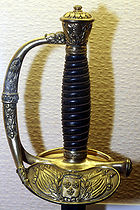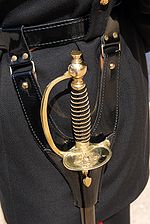
Small sword
Encyclopedia

Sword
A sword is a bladed weapon used primarily for cutting or thrusting. The precise definition of the term varies with the historical epoch or the geographical region under consideration...
designed for thrusting which evolved out of the longer and heavier rapier
Rapier
A rapier is a slender, sharply pointed sword, ideally used for thrusting attacks, used mainly in Early Modern Europe during the 16th and 17th centuries.-Description:...
of the late Renaissance
Renaissance
The Renaissance was a cultural movement that spanned roughly the 14th to the 17th century, beginning in Italy in the Late Middle Ages and later spreading to the rest of Europe. The term is also used more loosely to refer to the historical era, but since the changes of the Renaissance were not...
. The height of the small sword's popularity was between mid 17th and late 18th century. It is thought to have appeared in France
France
The French Republic , The French Republic , The French Republic , (commonly known as France , is a unitary semi-presidential republic in Western Europe with several overseas territories and islands located on other continents and in the Indian, Pacific, and Atlantic oceans. Metropolitan France...
and spread quickly across the rest of Europe
Europe
Europe is, by convention, one of the world's seven continents. Comprising the westernmost peninsula of Eurasia, Europe is generally 'divided' from Asia to its east by the watershed divides of the Ural and Caucasus Mountains, the Ural River, the Caspian and Black Seas, and the waterways connecting...
. The small sword was the immediate predecessor of the French foil
Foil (fencing)
A foil is a type of weapon used in fencing. It is the most common weapon in terms of usage in competition, and is usually the choice for elementary classes for fencing in general.- Components:...
(from which the épée developed) and its method of use—as typified in the works of such authors as Sieur de Liancour, Domenico Angelo
Domenico Angelo
Domenico Angelo , fencing master, was born in Leghorn, Italy, as Angelo Domenico Malevolti Tremamondo.According to the Encyclopaedia Britannica, "Angelo was the first to emphasize fencing as a means of developing health, poise, and grace...
, Monsieur J. Olivier, and Monsieur L'Abbat—developed into the techniques of the French classical school of fencing. Small swords were also used as status symbols and fashion accessories; for most of the 18th century anyone, civilian or military, with pretensions to gentleman
Gentleman
The term gentleman , in its original and strict signification, denoted a well-educated man of good family and distinction, analogous to the Latin generosus...
ly status would have worn a small sword on a daily basis.

Duel
A duel is an arranged engagement in combat between two individuals, with matched weapons in accordance with agreed-upon rules.Duels in this form were chiefly practised in Early Modern Europe, with precedents in the medieval code of chivalry, and continued into the modern period especially among...
ling weapon, and some systems for the use of the bayonet were developed using the method of the smallsword as their foundation, (including perhaps most notably, that of Alfred Hutton
Alfred Hutton
Alfred Hutton was a Victorian officer of the King's Dragoon Guards, antiquarian and swordsman. He originated the first English revival of historical fencing, together with his colleagues Egerton Castle, Captain Carl Thimm, Colonel Cyril Matthey, Captain Percy Rolt, Captain Ernest George Stenson...
).
Militarily, small swords continued to be used as a standard sidearm for infantry officers. In some branches with strong traditions, this practice continues to the modern day, albeit for ceremonial and formal dress only. The carrying of swords by officers in combat conditions was frequent in World War I
World War I
World War I , which was predominantly called the World War or the Great War from its occurrence until 1939, and the First World War or World War I thereafter, was a major war centred in Europe that began on 28 July 1914 and lasted until 11 November 1918...
and still saw some practice in World War II
World War II
World War II, or the Second World War , was a global conflict lasting from 1939 to 1945, involving most of the world's nations—including all of the great powers—eventually forming two opposing military alliances: the Allies and the Axis...
. The 1913 U.S. Army Manual of Bayonet Drill includes instructions for how to fight a man on foot with a small sword. Small swords are still featured on parade uniforms of some corps.

Rhombus
In Euclidean geometry, a rhombus or rhomb is a convex quadrilateral whose four sides all have the same length. The rhombus is often called a diamond, after the diamonds suit in playing cards, or a lozenge, though the latter sometimes refers specifically to a rhombus with a 45° angle.Every...
and spindle
Spindle (textiles)
A spindle is a wooden spike used for spinning wool, flax, hemp, cotton, and other fibres into thread. It is commonly weighted at either the bottom middle or top, most commonly by a circular or spherical object called a whorl, and may also have a hook, groove or notch, though spindles without...
-shaped cross-sections inherited from older weapons, like the rapier
Rapier
A rapier is a slender, sharply pointed sword, ideally used for thrusting attacks, used mainly in Early Modern Europe during the 16th and 17th centuries.-Description:...
. This triangular cross-section may be hollow ground for additional lightness. Many small swords of the period between the 17th and 18th centuries were found with colichemarde
Colichemarde
Colichemarde is a type of small sword blade that was popular from the late 17th century to the middle 18th century.-Overview:The small sword is considered to be a descendant of the "transition rapier", which itself evolved from the rapier due to the demand for a lighter sword better suited to...
blades.
Hilt
The small sword guard is typically of the "shell" type, sometimes with two lobes that were decorated as clam shells. The shells were often replaced with a simple curved oval disk, which was still referred to as the coquille (shell). In later foilsFoil (fencing)
A foil is a type of weapon used in fencing. It is the most common weapon in terms of usage in competition, and is usually the choice for elementary classes for fencing in general.- Components:...
, the lobed type evolved into the "lunette" or figure-8 guard, and the disk became the modern foil "bell" guard, but the guards were still referred to as coquilles. Small swords with this type of guard normally included other features of the older rapier
Rapier
A rapier is a slender, sharply pointed sword, ideally used for thrusting attacks, used mainly in Early Modern Europe during the 16th and 17th centuries.-Description:...
hilt, including quillons, ricasso
Ricasso
A ricasso is a part of sword and knife blades. It is the section just above the guard or handle. It is sometimes unsharpened and unbevelled.The first unsharpened ricassos were found on Middle Bronze Age swords...
, knuckle-bow, and a pas d'âne, although these were often atrophied beyond the point of usefulness, serving mainly as a decorative element. However, they were maintained in a usable state on some weapons, including the Italian foil, into the 20th century.
In the 19th century, simple cross-hilt small swords were also produced, largely as ceremonial weapon
Ceremonial weapon
A ceremonial weapon is an object used for ceremonial purposes to display power or authority. They are often used in parades, and as part of dress uniforms.Although they are descended from weapons used in actual combat, they are not normally used as such...
s that were evocative of more ancient types of weapons. An example is the Model 1840 Army Noncommissioned Officers' Sword
Model 1840 Army Noncommissioned Officers' Sword
The Model 1840 Noncommissioned Officers' Sword was based on a German version of the infantry sword used by British troops during the Napoleonic Wars...
, which is still used by the United States Army
United States Army
The United States Army is the main branch of the United States Armed Forces responsible for land-based military operations. It is the largest and oldest established branch of the U.S. military, and is one of seven U.S. uniformed services...
on ceremonial occasions. As the wearing of swords fell out of fashion and the small sword evolved into the duelling sword (forerunner of the modern épée), the older hilts gave way to simpler grips such as the French grip and Italian grip.
Use
The use of the small sword for infantry is covered in the US manual of 1861 titled "The Militiaman's Manual". It can be obtained here: http://books.google.com/books?id=3moDAAAAYAAJ&pg=PP8&dq=the+militiaman%27s+manual&ei=Ji0hS7KwL57AzgSchtTGDw&cd=1#v=onepage&q=&f=false.In modern times, the sword is often used as part of court uniform and dress
Court uniform and dress
- Court dress :On formal royal occasions in monarchies the dress worn by those present is prescribed by official regulations.Court dress is worn by all men not entitled to court uniform or military uniform on all occasions of state where such are customarily worn...
.

